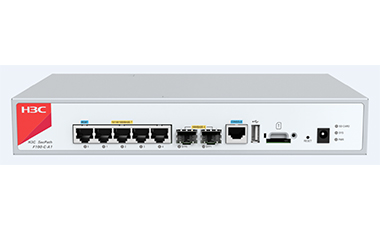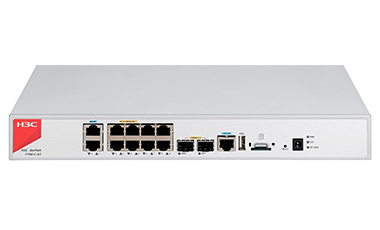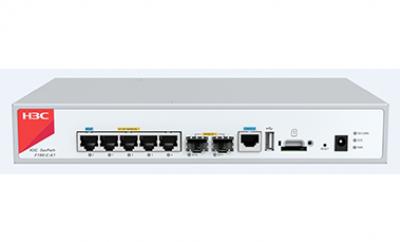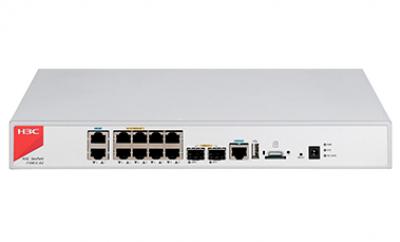|
Ports
|
5 × GE + 2 × SFP
(MTU: 1500 defaultly)
|
10 × GE + 2 × SFP
|
|
Storage media
|
TF card with a maximum size of 500 GB
|
|
Ambient temperature
|
Operating: 0°C to 45°C (32°F to 113°F)
Storage: –40°C to +70°C (–40°F to +158°F)
|
|
Operating mode
|
Route, transparent, or hybrid
|
|
AAA
|
Portal authentication
RADIUS authentication
HWTACACS authentication
PKI/CA (X.509 format) authentication
Domain authentication
CHAP authentication
PAP authentication
|
|
Firewall
|
SOP virtual firewall technology, which supports full virtualization of hardware resources, including CPU, memories, and storage
Security zone
Attack protection against malicious attacks, such as land, smurf, fraggle, ping of death, teardrop, IP spoofing, IP fragmentation, ARP spoofing, reverse ARP lookup, invalid TCP flag, large ICMP packet, address/port scanning, SYN flood, ICMP flood, UDP flood, and DNS query flood
Basic and advanced ACLs
Time range-based ACL
User-based and application-based access control
ASPF application layer packet filtering
Static and dynamic blacklist function
MAC-IP binding
MAC-based ACL
802.1Q VLAN transparent transmission
Sub-Interface VLAN
|
|
Antivirus
|
Signature-based virus detection
Manual and automatic upgrade for the signature database
Stream-based processing
Virus detection based on HTTP, FTP, SMTP, and POP3
Virus types include Backdoor, Email-Worm, IM-Worm, P2P-Worm, Trojan, AdWare, and Virus
Virus logs and reports
|
|
Deep intrusion prevention
|
Prevention against common attacks such as hacker, worm/virus, Trojan, malicious code, spyware/adware, DoS/DDoS, buffer overflow, SQL injection, and IDS/IPS bypass
Attack signature categories (based on attack types and target systems) and severity levels (including high, medium, low, and notification)
Manual and automatic upgrade for the attack signature database (TFTP and HTTP).
P2P/IM traffic identification and control
|
|
Email/webpage/ application layer filtering
|
Email filtering
SMTP email address filtering
Email subject/content/attachment filtering
Webpage filtering
HTTP URL/content filtering
Java blocking
ActiveX blocking
SQL injection attack prevention
|
|
NAT
|
Many-to-one NAT, which maps multiple internal addresses to one public address
Many-to-many NAT, which maps multiple internal addresses to multiple public addresses
One-to-one NAT, which maps one internal address to one public address
NAT of both source address and destination address
External hosts access to internal servers
Internal address to public interface address mapping
NAT support for DNS
Setting effective period for NAT
NAT ALGs for NAT ALG, including DNS, FTP, H.323, ILS, MSN, NBT, PPTP, and SIP
|
|
VPN
|
L2TP VPN
IPSec VPN
GRE VPN
SSL VPN
|
|
IP Services
|
IP Forwarding
ICMP, Tracert, ping, Telnet, DHCP Server, DCHP Relay, and DHCP Client
Routing: Static, RIP, OSPF, BGP
Multicast: IGMP, PIM-SM and PIM-DM
VRRP
IPv6 status firewall
IPv6 attack protection
IPv6 forwarding
IPv6 protocols such as ICMPv6, PMTU, Ping6, DNS6, TraceRT6, Telnet6, DHCPv6 Client, and DHCPv6 Relay
IPv6 routing: RIPng, OSPFv3, BGP4+, static routing, policy-based routing
IPv6 multicast: PIM-SM, and PIM-DM
IPv6 transition techniques: NAT-PT, IPv6 tunneling, NAT64 (DNS64), and DS-LITE
IPv6 security: NAT-PT, IPv6 tunnel, IPv6 packet filter, RADIUS, IPv6 zone pair policies, IPv6 connection limit
|
|
Encryption algorithm
|
MD5/SHA1/SHA256/SHA384/SHA512/SM3/3DES-CBC/AES-CBC-128/ AES-CBC-192/ AES-CBC-256/DES-CBC/SM1-CBC-128/SM4-CBC
|
|
Configuration management
|
CLI Configuration management via console port
Remote management through Web, SSH
Device management through H3C IMC SSM
SNMPv3, compatible with SNMPv2 and SNMPv1
Intelligent security policy
|
|
Environmental protection
|
EU RoHS compliance
|




